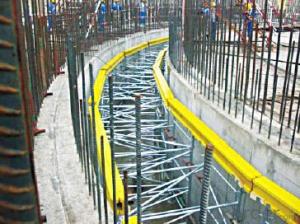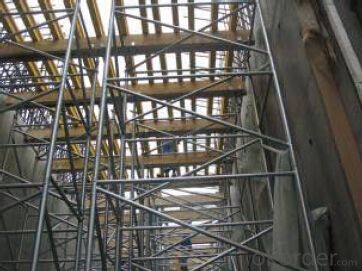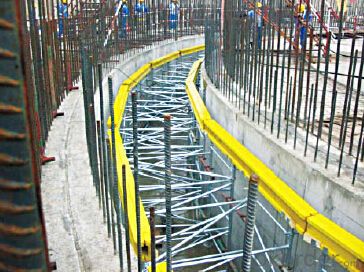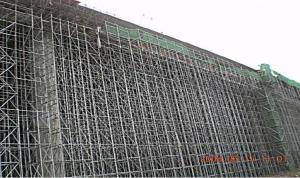Tower scaffolding for Formwork and Scaffolding Systems
- Loading Port:
- Tianjin
- Payment Terms:
- TT OR LC
- Min Order Qty:
- 50 m²
- Supply Capability:
- 1000 m²/month
OKorder Service Pledge
Quality Product, Order Online Tracking, Timely Delivery
OKorder Financial Service
Credit Rating, Credit Services, Credit Purchasing
You Might Also Like
Tower Scaffolding
Shoring tower is an effective supporting system. It is easy to assemble and dismantlement, and
has excellent stability and bearing capacity. It has been widely used in the construction of industry
& residential buildings , bridges, tunnels and dam project, etc.
Characteristics:
◆ High degree of standardization.
◆ Easy storage and transportation

- Q: What are the weight limits for steel formwork panels?
- The weight limits for steel formwork panels can vary depending on their size, thickness, and design. It is best to refer to the manufacturer's specifications or guidelines for the specific weight limits of the steel formwork panels being used.
- Q: Can steel formwork be used for both straight and curved structures?
- Indeed, both straight and curved structures can utilize steel formwork. The versatility of steel formwork allows for effortless shaping and adjustment, enabling the construction of diverse geometric designs. These designs encompass straight walls, columns, arches, and curved walls. Such flexibility facilitates the realization of exceptional architectural concepts and structures. Moreover, the strength and durability of steel formwork render it appropriate for employment in both straight and curved structures.
- Q: Is steel formwork reusable?
- Yes, steel formwork is reusable. It is a durable and sturdy material that can be dismantled and used multiple times for different construction projects.
- Q: How does steel formwork handle different concrete pouring techniques?
- Steel formwork is highly versatile and can handle various concrete pouring techniques with ease. Its sturdy structure and durability enable it to withstand the pressure and weight of different concrete pouring methods, such as pouring by hand, pouring with a pump, or pouring using a crane. The steel formwork provides excellent support and stability, ensuring that the concrete maintains its desired shape and structure during the pouring process. Additionally, steel formwork can be easily adjusted and customized to accommodate different pouring techniques, making it a preferred choice for construction projects that require flexibility and adaptability.
- Q: What are the different types of supports used in steel formwork installation?
- There are several types of supports that are commonly used in steel formwork installation. These supports are essential for providing stability and ensuring the structural integrity of the formwork system. Some of the different types of supports used in steel formwork installation include: 1. Adjustable Props: Adjustable props are commonly used to support the weight of the formwork system. These props can be easily adjusted to the desired height and provide stability to the formwork during concrete pouring and curing. 2. Scaffolding: Scaffolding is another type of support that is frequently used in steel formwork installation. It provides a stable platform for workers to access and work on the formwork system. Scaffolding can be easily assembled and disassembled, making it highly versatile and adaptable to different construction projects. 3. Beams and Girders: Beams and girders are used to provide horizontal support to the steel formwork. These structural elements distribute the load evenly across the formwork system, preventing any excessive deflection or deformation. 4. Bracing: Bracing is essential for maintaining the stability of the formwork system during concrete pouring and curing. It consists of diagonal supports that prevent lateral movement and ensure that the formwork remains in place. 5. Anchors and Tie Rods: Anchors and tie rods are used to secure the formwork system to the existing structure. These elements provide additional support and prevent any movement or displacement of the formwork during the concrete pouring process. 6. Wall Ties: Wall ties are used to hold the formwork panels together and provide lateral support. These ties are typically made of steel and are designed to withstand the pressure exerted by the concrete during pouring and curing. 7. Wedges and Clamps: Wedges and clamps are used to secure the formwork panels in place. These elements ensure that the formwork remains tightly fitted and prevents any leakage of concrete during pouring. Overall, the selection of the appropriate type of support for steel formwork installation depends on various factors such as the size and complexity of the structure, the load-bearing capacity required, and the site conditions. It is crucial to carefully consider these factors and choose the most suitable supports to ensure a safe and efficient formwork installation process.
- Q: How does steel formwork affect the overall accuracy of concrete structures?
- The accuracy of concrete structures can be significantly improved through the use of steel formwork. By providing precise alignment and dimensional accuracy, steel formwork ensures a more uniform and accurate structure. To maintain the desired shape and dimensions of the concrete during pouring and curing, steel formwork offers a rigid and stable framework. This stability prevents any potential deformation or distortion, ensuring that the final structure adheres to its design specifications. Additionally, steel formwork contributes to a smoother surface finish of the concrete. The smoothness of the formwork surface reduces the likelihood of imperfections or irregularities in the final structure, ultimately enhancing its aesthetics and overall quality. Moreover, steel formwork allows for greater control and precision in the placement and positioning of reinforcement bars, which are crucial for the structural integrity of the concrete. Accurate placement of reinforcement bars guarantees proper embedding within the concrete, resulting in a stronger and more durable structure. Furthermore, the high level of reusability provided by steel formwork further enhances accuracy. Its durability allows for multiple uses, minimizing the risk of wear and tear that could affect the formwork's alignment and accuracy. In conclusion, steel formwork plays a vital role in ensuring the overall accuracy of concrete structures. It provides stability, precise alignment, smooth formwork surfaces, and reusability, all of which contribute to a more accurate and aesthetically pleasing final product.
- Q: What are the features of the new building template?
- No need to be used again after the molding process. The periphery of the template with plate fixation, and a groove can be inserted, the template is extended.
- Q: How does steel formwork handle different concrete bleeding rates?
- Steel formwork is a highly versatile and robust material capable of effectively managing varying rates of concrete bleeding. Concrete bleeding refers to the phenomenon where water within the concrete mixture rises to the surface, leaving behind an excess layer of water. This excess water can lead to numerous issues during the curing process, including reduced strength, increased porosity, and surface defects. Typically, steel formwork is designed with tight joints and a smooth surface, which aids in minimizing concrete bleeding. The tight joints prevent excessive water from escaping through the formwork, while the smooth surface allows for easy removal of any excess water that does bleed out. This helps maintain the desired water-cement ratio and ensures proper hydration and curing of the concrete. Furthermore, steel formwork is a rigid and sturdy material capable of withstanding the pressure exerted by the concrete during pouring and curing. This strength enables the formwork to retain its shape and prevent any bulging or deformation caused by concrete bleeding. In situations where the concrete exhibits a high bleeding rate, steel formwork can be reinforced with additional support systems such as braces or tie rods. These reinforcements strengthen the formwork and ensure it can withstand the increased pressure resulting from excessive bleeding. Moreover, steel formwork can be easily cleaned and reused for multiple projects. This means that any residual water or bleeding from previous concrete pours can be effectively eliminated, providing a fresh and clean surface for subsequent pours. In summary, steel formwork is a well-suited choice for managing various concrete bleeding rates. Its tight joints, smooth surface, strength, and ability to be reinforced make it an ideal option for effectively handling bleeding in concrete construction projects.
- Q: What are the main components of steel formwork?
- The steel formwork system consists of panels, stiffeners, and connecting brackets as its main components. The panels, which are constructed from high-quality steel sheets, are known for their rigidity and durability. They are available in various sizes and shapes, including rectangular, square, or circular, depending on the desired shape of the concrete structure. These panels are designed to endure the pressure exerted by the concrete during pouring and curing. To reinforce the steel formwork panels and enhance their load-bearing capacity, stiffeners are employed. These stiffeners are typically welded or bolted onto the panels to provide additional strength and stability. They play a crucial role in projects of larger scale or when dealing with heavy concrete loads. Connecting brackets serve as a vital element in the assembly of the steel formwork system. They are used to connect the formwork panels together, ensuring proper alignment and stability. Made of steel, these brackets securely hold the formwork panels in place. They are simple to install and remove, allowing for efficient and convenient formwork assembly. In summary, steel formwork offers several advantages, such as high strength, durability, and reusability. Its main components, including panels, stiffeners, and connecting brackets, work collaboratively to create a sturdy and dependable system capable of withstanding concrete pouring pressure and delivering a smooth and precise surface finish.
- Q: How does steel formwork affect the overall safety of a building project?
- Steel formwork plays a crucial role in enhancing the overall safety of a building project. Firstly, steel formwork is known for its high strength and durability, which ensures a stable structure during the construction process. This stability is essential in preventing accidents such as collapses or structural failures that can cause serious injuries or fatalities. Moreover, steel formwork provides a secure and reliable platform for workers to perform their tasks. The rigid structure minimizes the risks of slips, trips, and falls, which are common causes of accidents on construction sites. Additionally, steel formwork can be designed to include safety features such as handrails, guardrails, and non-slip surfaces, further enhancing worker safety. Another significant advantage of steel formwork is its fire-resistant properties. Steel is non-combustible, meaning it does not contribute to the spread of fire. This characteristic significantly reduces the potential for fire-related accidents in a building project, safeguarding both the workers and the structure itself. Furthermore, steel formwork is highly resistant to adverse weather conditions, such as heavy winds, rain, or earthquakes. This resistance ensures that the structure remains stable and secure even during extreme weather events, minimizing the risks of accidents or damage caused by these external factors. Lastly, steel formwork offers better quality control compared to other types of formwork materials. The precise and consistent dimensions of steel formwork reduce the chances of errors or inconsistencies in the construction process, resulting in a safer and more reliable end product. In conclusion, steel formwork positively impacts the overall safety of a building project by providing stability, a secure working platform, fire resistance, weather resistance, and improved quality control. These factors collectively contribute to reducing the risks of accidents, injuries, and structural failures, making steel formwork an essential component in ensuring a safe construction environment.
Send your message to us
Tower scaffolding for Formwork and Scaffolding Systems
- Loading Port:
- Tianjin
- Payment Terms:
- TT OR LC
- Min Order Qty:
- 50 m²
- Supply Capability:
- 1000 m²/month
OKorder Service Pledge
Quality Product, Order Online Tracking, Timely Delivery
OKorder Financial Service
Credit Rating, Credit Services, Credit Purchasing
Similar products
Hot products
Hot Searches
Related keywords



















